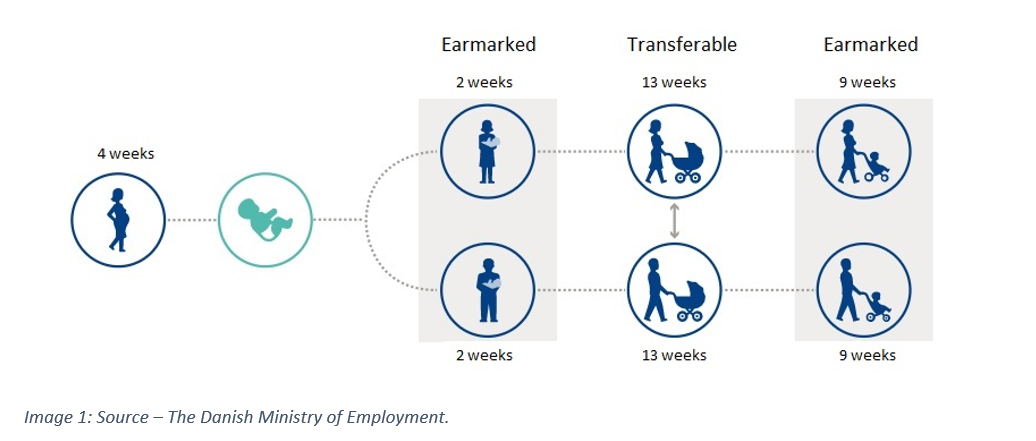New rules on parental leave with effect for children born on 2 August 2022 and later
On 3 March 2022, the Danish Parliament adopted the bill on amendments of the act on parental leave. From 1 July 2022, new rules will thus apply for the distribution of the parental leave period, just as new rules are introduced for LGBT+ families and single parents which will apply from 1 January 2024.
Adoption of the new rules
Based on the EU directive on parental leave, the Danish Parliament on 3 March 2022 adopted the bill amending the current act on parental leave. The changes are based on EU’s wish for earmarked leave for both parents with the purpose of creating a better work life balance and thereby promoting gender equality.
The new rules apply for parents of children born on 2 August 2022 or later 1.
The new leave periods
Pursuant to the new rules, the mother is still entitled to 4 weeks of leave before the birth, just as the mother is obligated to have minimum two weeks of leave after the birth. After this period, the mother is entitled to have further 8 weeks of leave which (in whole or in part) can be transferred to the father/co-mother. After this period, the mother is entitled to a leave of further 32 weeks (now called “leave”) with a possibility of extension, as under the current rules. Compared to the current rules, the mother’s entitlement to maternity leave is reduced by 4 weeks.
As under the current rules, the father/co-mother is entitled to 2 weeks of paternity leave after the birth and is further entitled to 32 weeks of leave, with a possibility of extension.
The leave periods are illustrated below:

Payment during the leave
With the adoption of the new rules, the distribution of the allowance is equally divided between the mother and the father/co-mother, which means that each party (after the birth), as a rule, can receive allowance for 24 weeks. The total amount of allowance is thus unchanged compared to the current rules.
From the 48 weeks of allowance, 2+9 weeks are earmarked each party, if both parents are employed, and these weeks cannot be transferred, whereas the remaining 26 weeks can be freely divided between the mother and the father/co-mother.
The leave allowance payment can be illustrated as follows:

If one or both parents is not considered as an “employee” (e.g. by being self-employed or a manager), only 2 of the weeks for the parent who is not a wage earner is earmarked. 22 weeks are thus transferable.
Single parents
In accordance with the new act on parental leave, single mothers and single fathers/co-mothers are regarded equally. This means that the single parent – whether this being the mother or the father/co-mother – is entitled to 46 weeks of paid leave after the birth.
From 1 January 2024, a single mother or father/co-mother can transfer a part of the leave period which is not earmarked to a close family member. This may be a sibling or a grandparent. The close family member, to whom the leave was transferred, must take the leave before the child reaches the age of 1.
As mentioned above, the number of transferable weeks of leave depends on whether the single parent is considered as an “employee”.
LGBT+ families
From 1 January 2024, LGBT+ families’ possibilities for leave will be improved, as the child’s so-called “legal” parents has the possibility to transfer the non-earmarked weeks of leave to so-called “social” parents. Examples of social parents could be the legal parent’s spouse, a known donor with a parental relationship to the child, or for example the known donor’s spouse or cohabitant who has a parental relationship to the child.
Bird & Bird’s comments
The new rules entail equality between the mother and the father/co-mother as regards the distribution of allowance during the leave. The same equality does not exist under the current rules of the Danish Salaried Employees Act, pursuant to which only the mother is entitled to half of the salary. It is therefore interesting to see whether the rules of the Danish Salaried Employees Act will also be amended so that the father/co-mother also obtains the same rights and thus reflects the principle of the act on parental leave.
Such equality already exists in the private labour market, where several companies offer (more) equal parental conditions to their female and male employees. Moreover, it is debatable whether maintaining different parental conditions for female and male employees could potentially be contrary to the rules of act on equal treatment.
1 However, cf. below regarding single parents and LGBT+ families.





